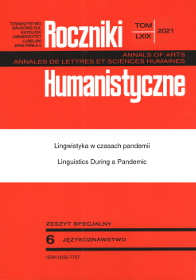Moral Support in the Time of the Pandemic: Discourse-Interactive Strategies Used in Comments Addressed to People with Covid-19
Abstract
The aim of this article is to analyse the discourse-interactive strategies applied by Spanish speakers in YouTube comments addressed to people infected by COVID-19. We are especially interested in the mechanisms that reflect support and solidarity. Our main assumption is that the comments that accompany YouTube videos constitute a special type of communication which, though not fulfilling the prototypical principle of “interactive reciprocity”, demonstrates a considerable level of interpersonal and interactive mutual influence. The strategies analysed (including greetings, expressive vocative forms, verbal empathy and signals of interest, compliments and praise, religious invocations, etc.) seem to indicate that the “pandemic reality” has contributed to the creation of a certain type of virtual community of practice that, in its own way, fulfils the interactive principle of solidarity, whilst simultaneously evaluating the time of the coronavirus epidemic.
References
Austin, John L. How To Do Things With Words. Clarendon Press, 1962.
Blanco, Xavier. «Les pragmatèmes: définition, typologie et traitement lexicographique». Verbum, vol. 4, 2013, págs. 17-25.
Bucholtz, Mary y Kira Hall. «Identity and interaction: a social-cultural linguistic approach.» Discourse Studies, vol. 7, N.° 4-5, 2005, págs. 585-614.
Carretero, Marta, Carmen Maíz-Arévalo y María-Ángeles Martínez. «‘Hope This Helps!’ An analysis of expressive speech acts in online task-oriented interaction by university students». Yearbook of Corpus Linguistics and Pragmatics, ed. Jesús Romero-Trillo, Springer International Publishing, 2014, págs. 261-289.
Chamorro Maldonado, Miguel Alejandro. «El conflicto catalán: discursos de los medios y expresiones discursivas de los usuarios en Youtube». Comunifé: Revista de Comunicación Social, vol. 18, N.° 18, 2018, págs. 65-75.
Dumitrescu, Domnita. «La expresión de buenos deseos hacia nuestro prójimo: ¿un acto de habla cortés automático?» Pragmática sociocultural: estudios sobre el discurso de cortesía en español, ed. Diana Bravo, Antonio Briz, Ariel, 2004, págs. 265-283.
Eckert, Penelope y Sally McConell-Ginet. «Communities of practice: Where language, gender, and power all live». Locating Power: Proceedings of the Second Berkeley Women and Language Conference, ed. Kira Hall y Mary Bucholtz, Berkeley Women and Language Group, 1992, págs. 89-99.
Gallardo Camacho, Jorge. «Análisis del fenómeno Yotube en España: Relación con los espectadores y los generadores de contenidos tradicionales». Revista Luciérnaga, vol. 5, N.° 9, 2013, págs. 57-68.
García González, Lidia A. «Aproximaciones al estudio del movimiento social #YoSoy132 a través del análisis de los cometarios de videos en YouTube». Versión. Estudios de Comunicación y Política, N.° 31, 2013, págs. 79-89.
Gharbi, Najwa. «Les pragmatèmes d’affect: délimitation définitoires et propriétés sémantico-pragmatiques». Lublin Studies in Modern Languages and Literature, vol. 42, N.° 4, 2018, págs. 150-170.
Haverkate, Henk. La cortesía verbal. Estudio paragmalingüístico. Gredos, 1994.
Katsiki, Stavroula. Les actes de langage dans une perspective interculturelle: L’exemple du vœu en français et en grec, Tesis doctoral inédita, Université Lumière Lyon 2, 2001.
Martin, James Robert, y Peter R. White. The language of Evaluation. Appraisal in English. Palgrave Macmillian, 2005.
Orduña-Malea, Enrique, Cristina I. Font-Julián y José-Antonio Ontalba- Ruipérez. «Covid-19: análisis métrico de vídeos y canales de comunicación en YouTube». El profesional de la información, vol. 29, N.° 4, 2020, págs. 1-14.
Peláez Torres, Marta. «Aproximación sociopragmática y pragmalingüística a la formulación de buenos deseos y felicitaciones en español». Pragmalingüística, N.° 25, 2017, págs. 467-489.
Sánchez-Olmos, Cande y Tamara Hidalgo-Marí. «Del sofá a YouTube: estudio de género sobre la interacción en la red social en torno a las series de TV españolas». Communication & Society, N.° 29 (2), 2016, págs. 117-132.
Copyright (c) 2021 Roczniki Humanistyczne

This work is licensed under a Creative Commons Attribution-NonCommercial-NoDerivatives 4.0 International License.





